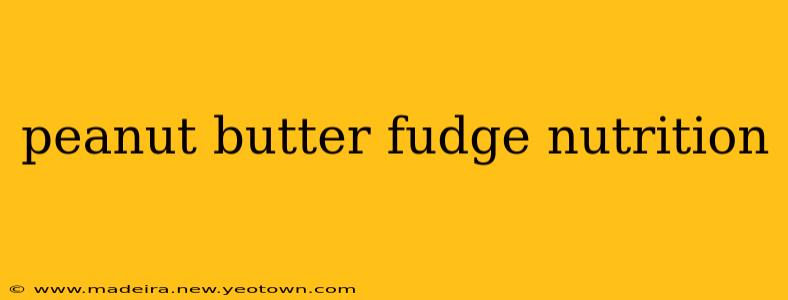Peanut Butter Fudge: A Delicious Treat, But What's the Nutritional Scoop?
Oh, peanut butter fudge. That rich, creamy, intensely peanutty delight that can transport you straight back to childhood. But before you dive headfirst into a whole pan (we won’t judge!), let’s take a closer look at the nutritional information behind this decadent dessert. Understanding the nutritional profile can help you enjoy it mindfully and make informed choices.
This isn't just about calories, folks. We'll delve into the specific components – fats, sugars, proteins, and more – to give you a complete picture. Think of this as your nutritional cheat sheet for your next peanut butter fudge craving.
How many calories are in peanut butter fudge?
This is a tough one to answer definitively because recipes vary wildly. A standard serving (let's say about 1 ounce or a small square) of homemade peanut butter fudge might contain anywhere from 150-250 calories. Store-bought versions can vary even more, often containing higher levels of added sugars and fats, bumping up the calorie count considerably. Always check the nutrition label on store-bought products for the most accurate information.
What are the main ingredients in peanut butter fudge, and how do they affect the nutritional content?
The foundation of most peanut butter fudge recipes includes:
-
Peanut butter: This contributes healthy fats (mostly unsaturated), protein, and fiber. The type of peanut butter you use (creamy vs. crunchy, natural vs. regular) will slightly alter the nutritional profile. Natural peanut butter, with only peanuts and maybe salt, generally boasts a higher protein and fiber content.
-
Sugar: This is the primary source of carbohydrates and significantly impacts the calorie count. The amount of sugar used can dramatically influence the overall nutritional value.
-
Butter or other fats: These add richness and texture but contribute significantly to the overall fat and calorie content.
-
Milk or cream (often): This adds moisture, richness, and contributes to the fat and protein content.
The ratios of these ingredients directly impact the nutritional breakdown. A fudge recipe heavy on sugar and butter will naturally be higher in calories and fat than one using less sugar and a healthier fat source (like a blend of butter and coconut oil).
Is peanut butter fudge healthy?
Let's be realistic: peanut butter fudge isn't a health food. It’s a treat best enjoyed in moderation. While peanut butter offers some nutritional benefits, the high sugar and fat content outweigh these positives when consumed in large quantities. Think of it as an occasional indulgence, not a regular part of a balanced diet.
What are the fat and sugar contents in peanut butter fudge?
Again, this varies considerably based on the recipe and ingredients used. However, you can expect a significant amount of both saturated and unsaturated fats, and a high level of added sugars. It's crucial to check the nutrition label on store-bought fudge or calculate it yourself based on your homemade recipe.
Are there healthier versions of peanut butter fudge?
Absolutely! You can make healthier versions by substituting some ingredients:
-
Reduce the sugar: Experiment with using less sugar or a sugar substitute like stevia or erythritol. However, be aware that these can impact taste and texture.
-
Use healthier fats: Incorporate more unsaturated fats by using a blend of butter and coconut oil, or even swapping to a completely plant-based butter alternative.
-
Add protein: Boost the protein content by adding protein powder (carefully, as this can impact the texture) or using Greek yogurt in place of some of the cream.
Remember, even healthier versions will still be relatively high in calories and fats. Portion control is key!
Enjoy your peanut butter fudge responsibly, savoring each bite while staying mindful of its nutritional impact. A little bit goes a long way!

